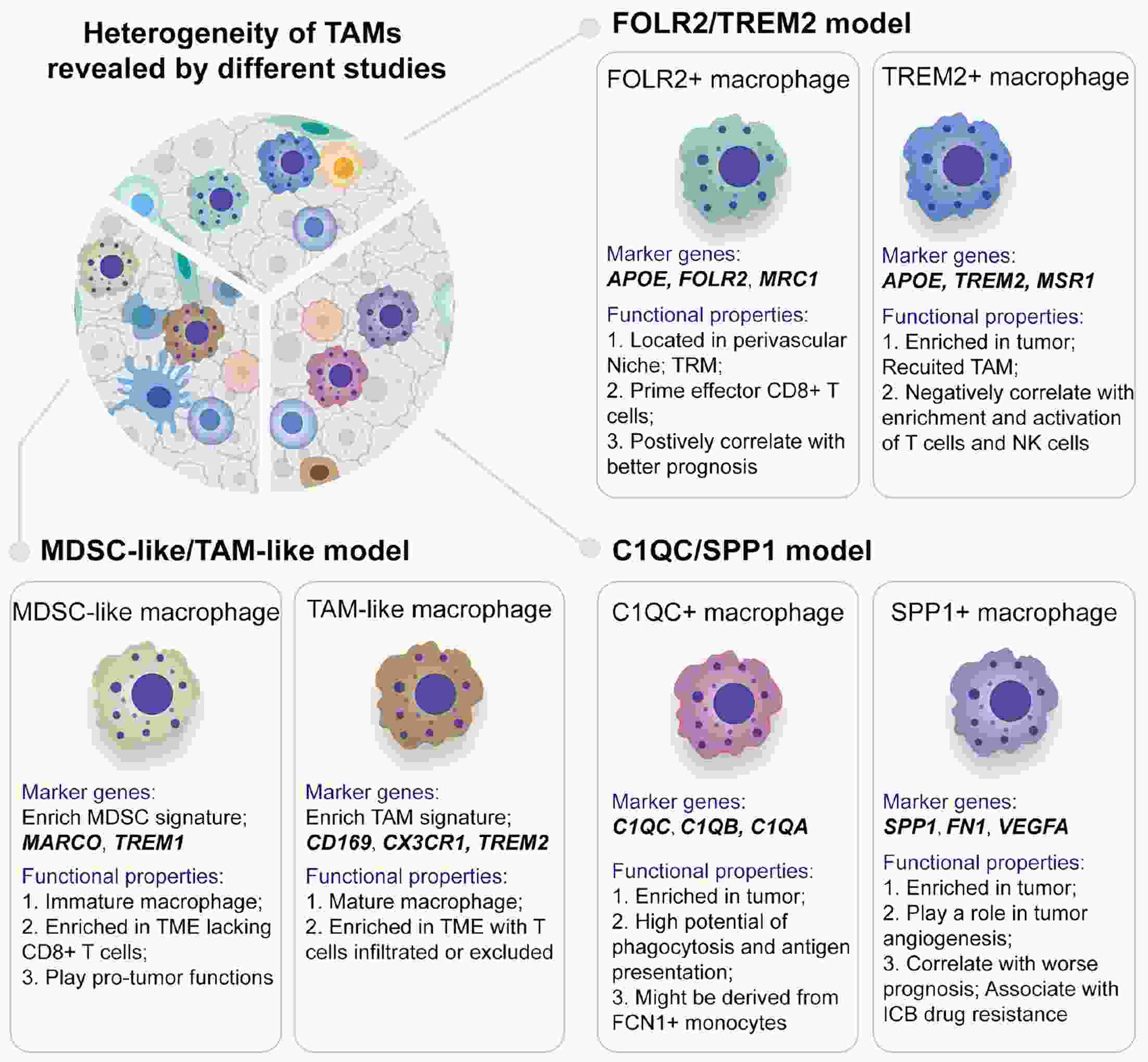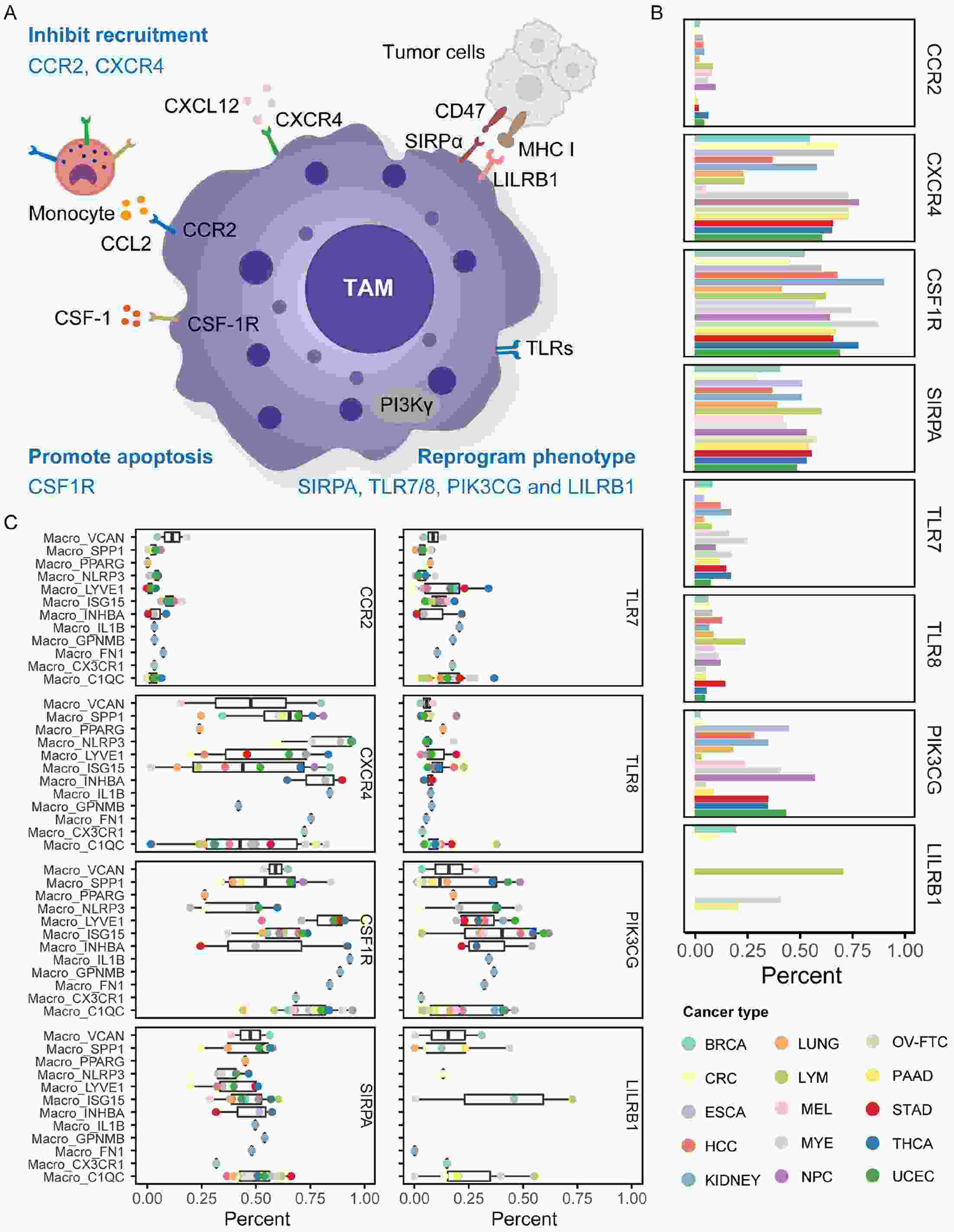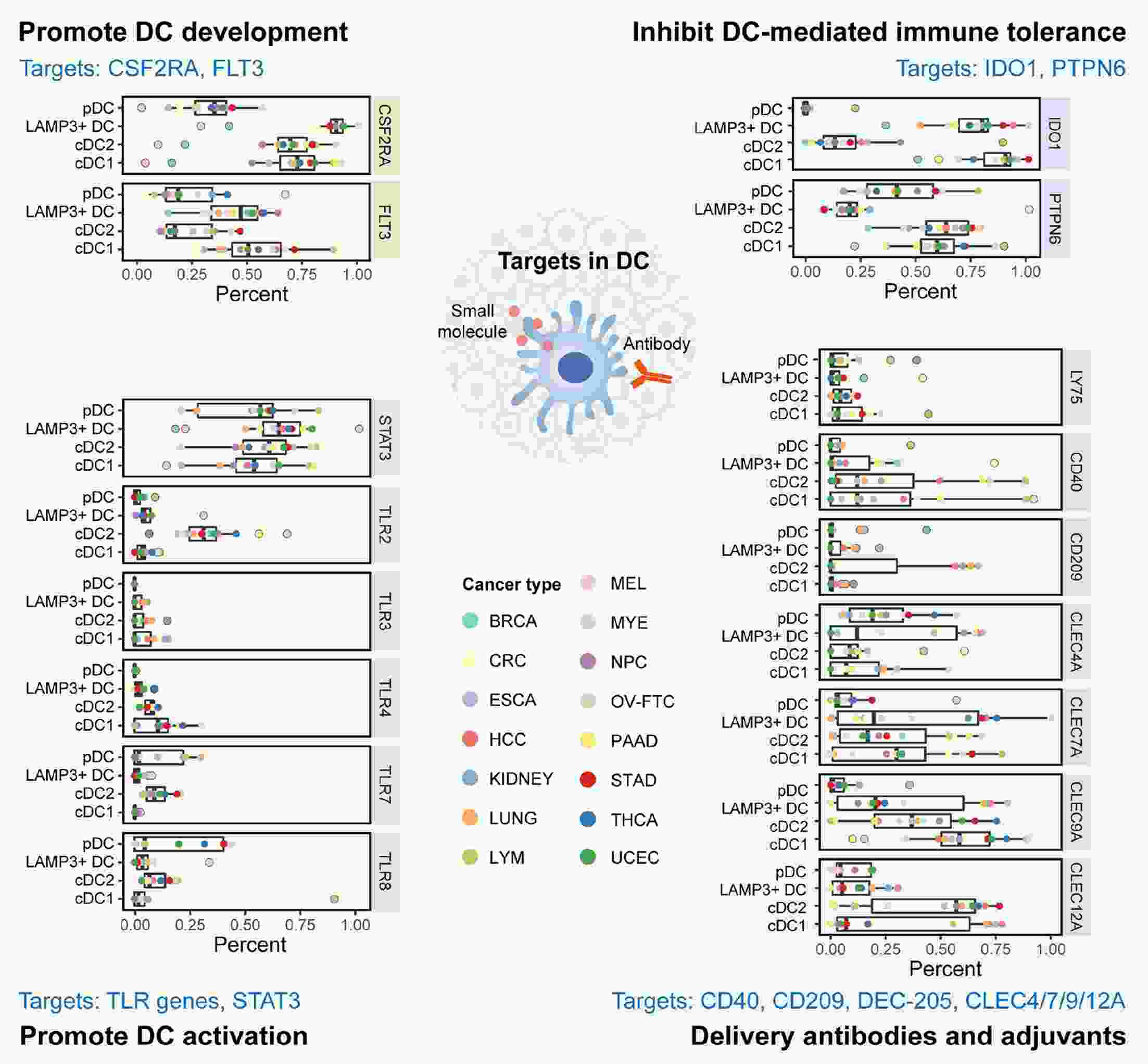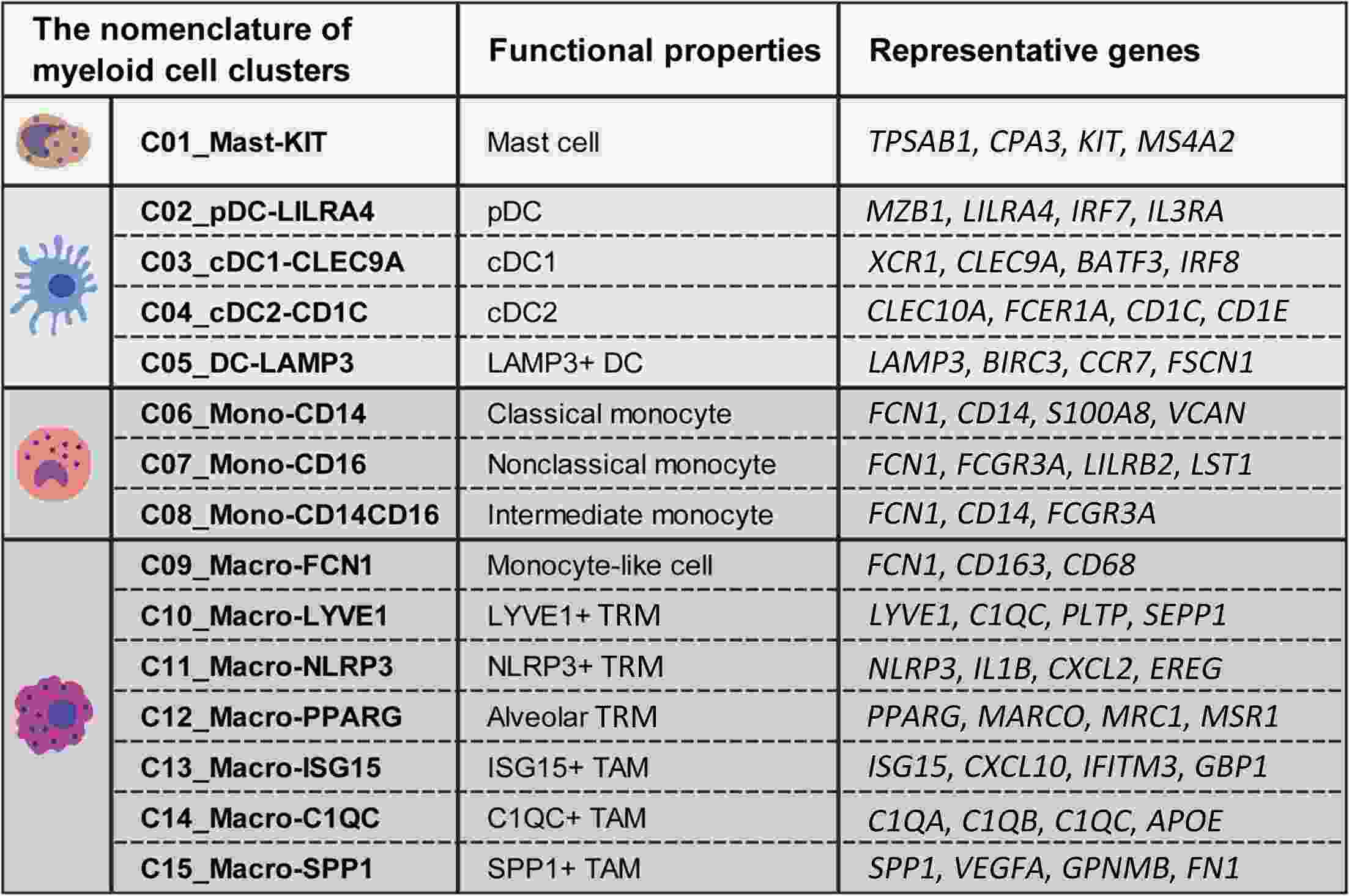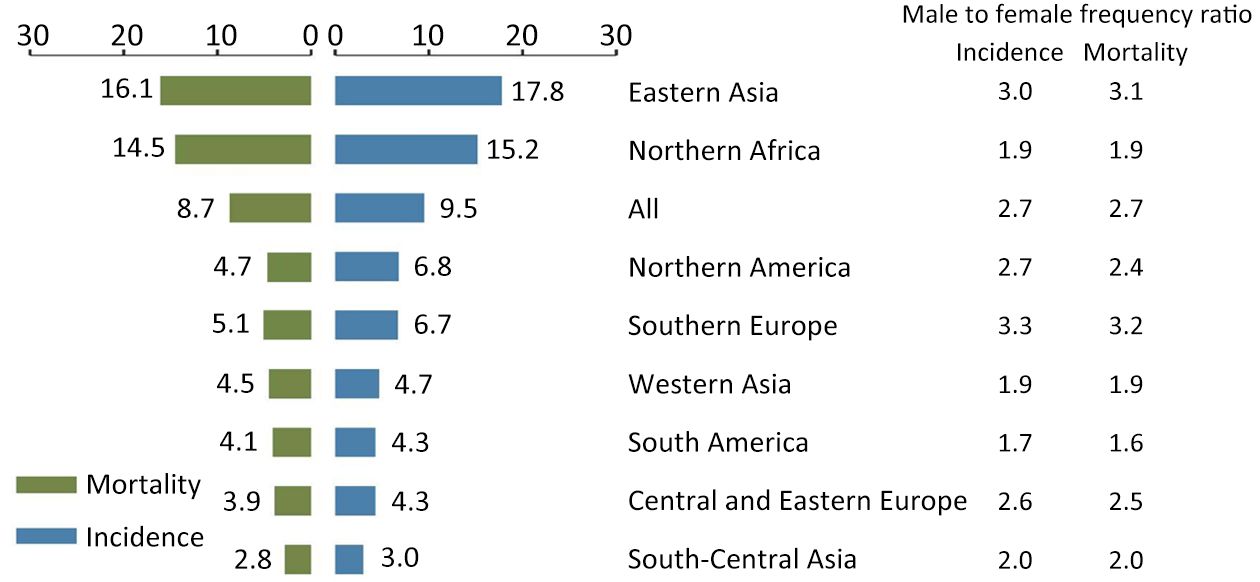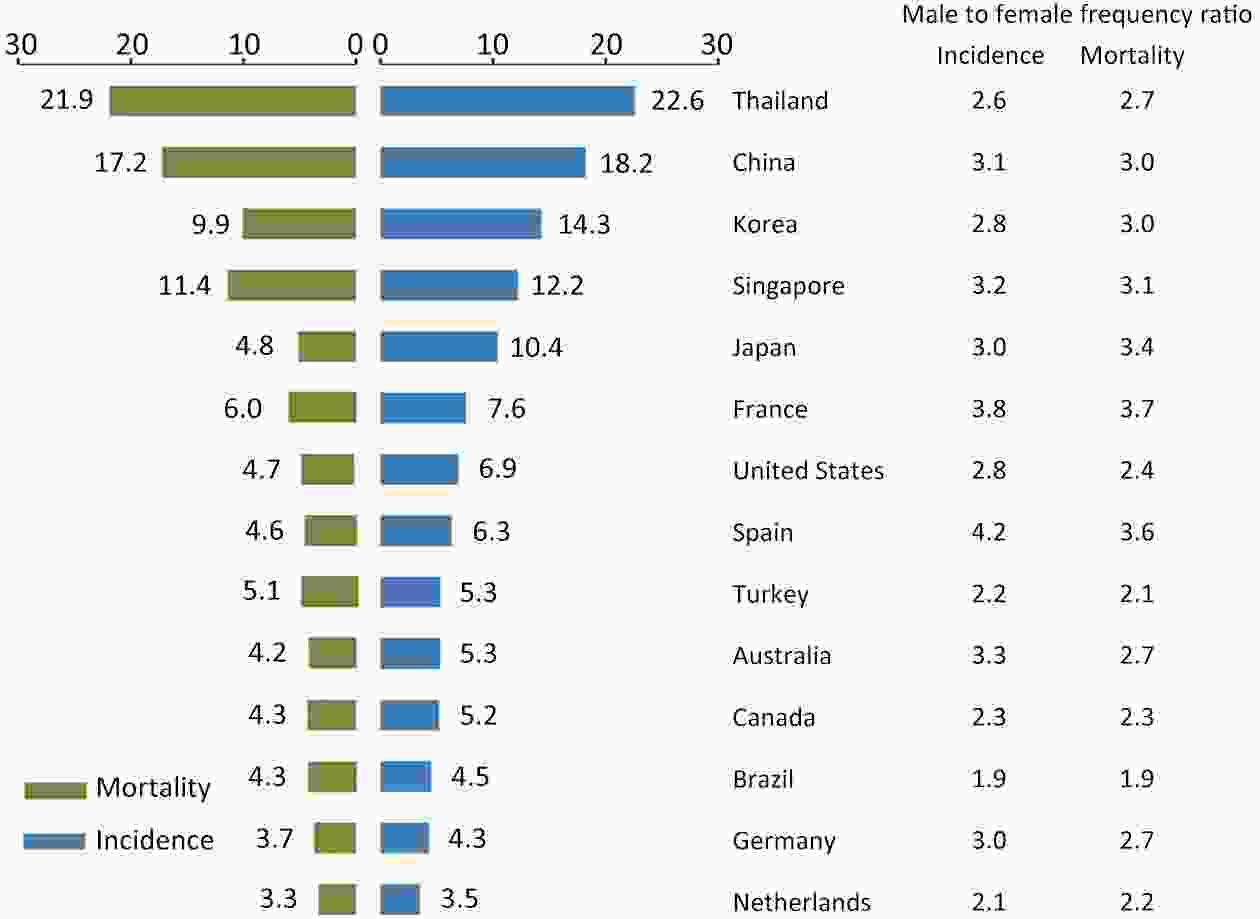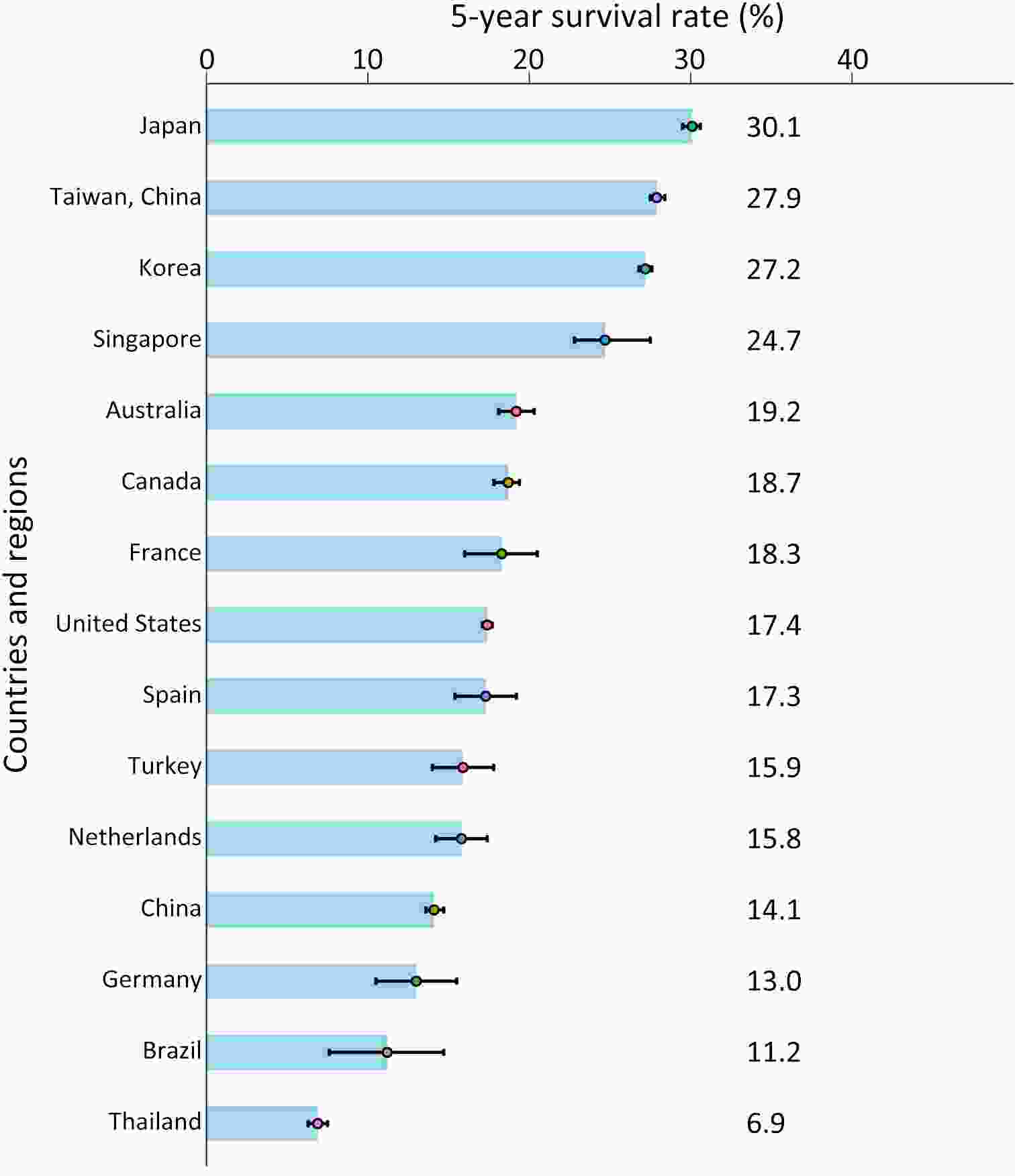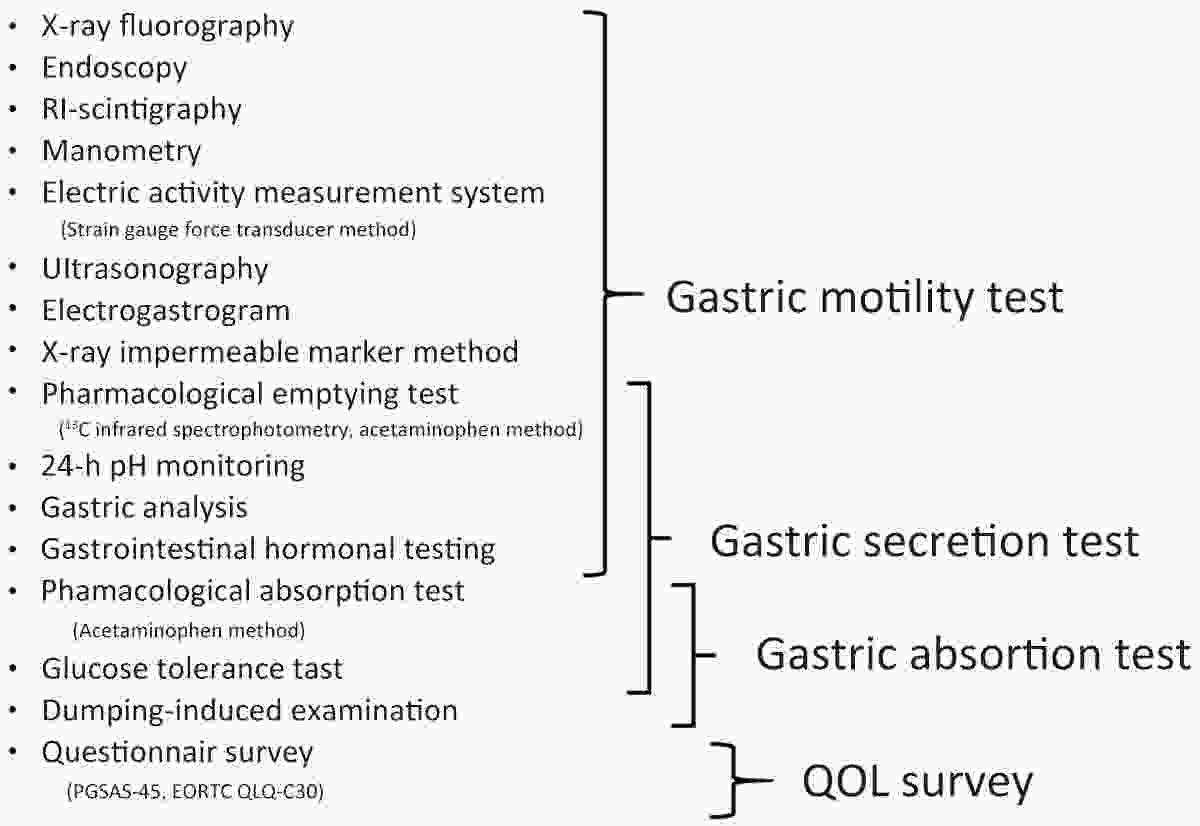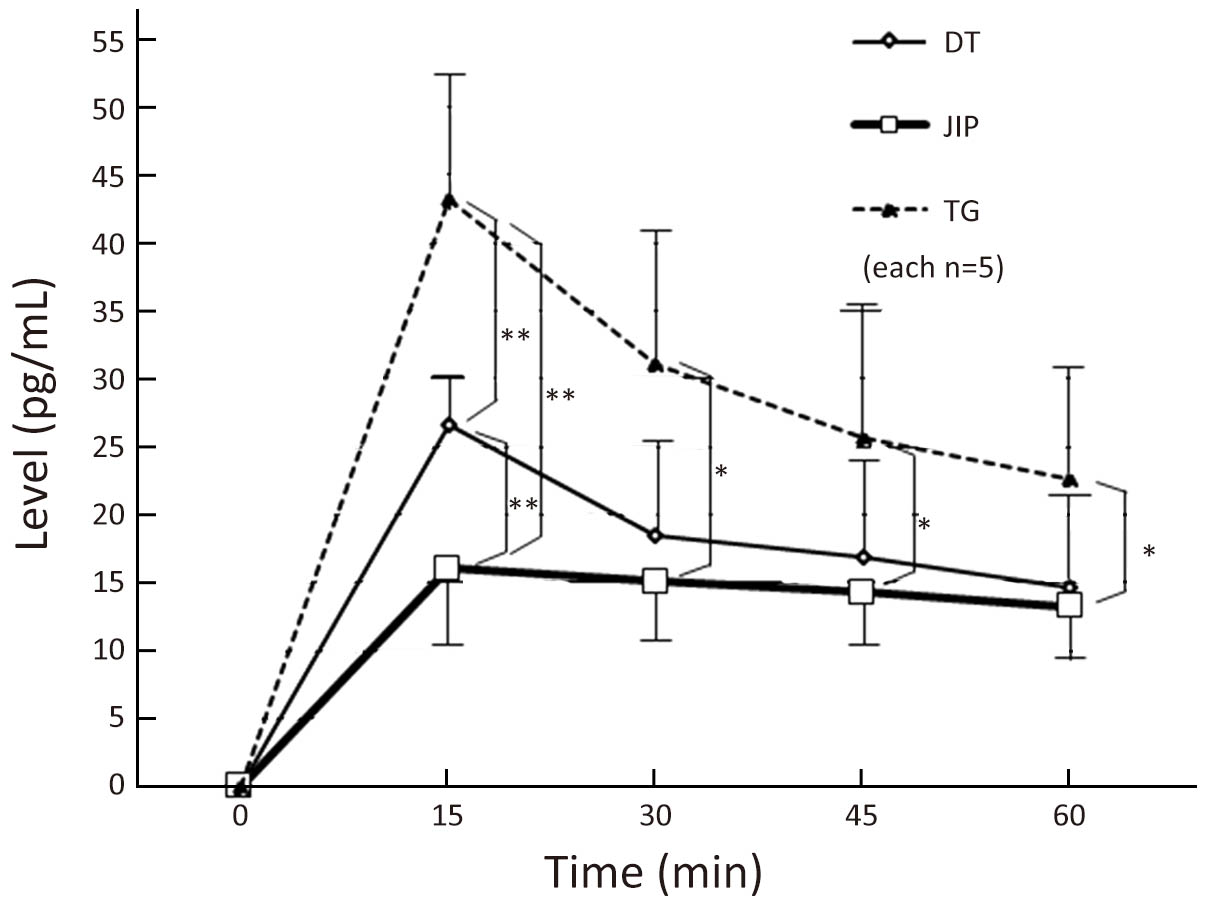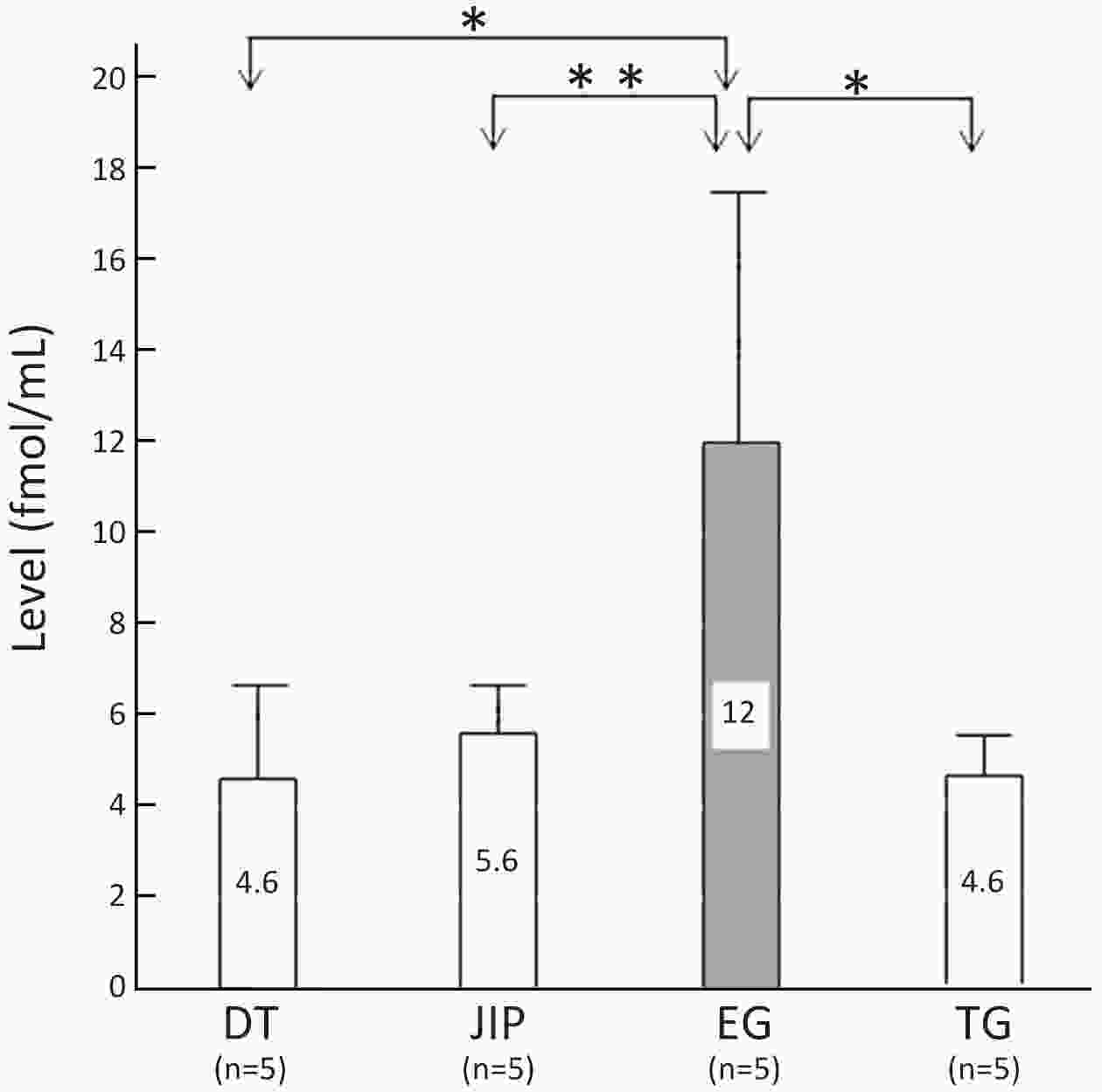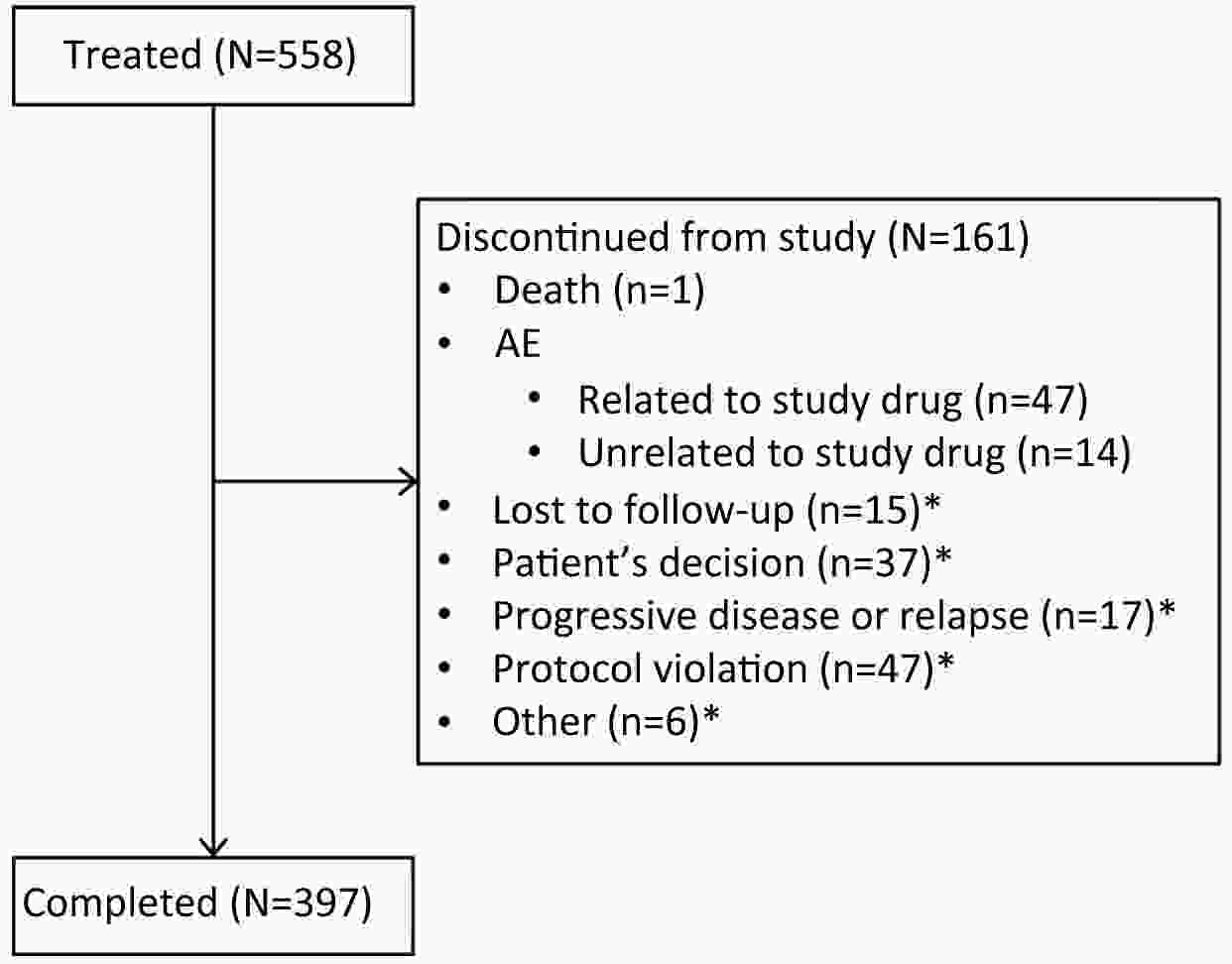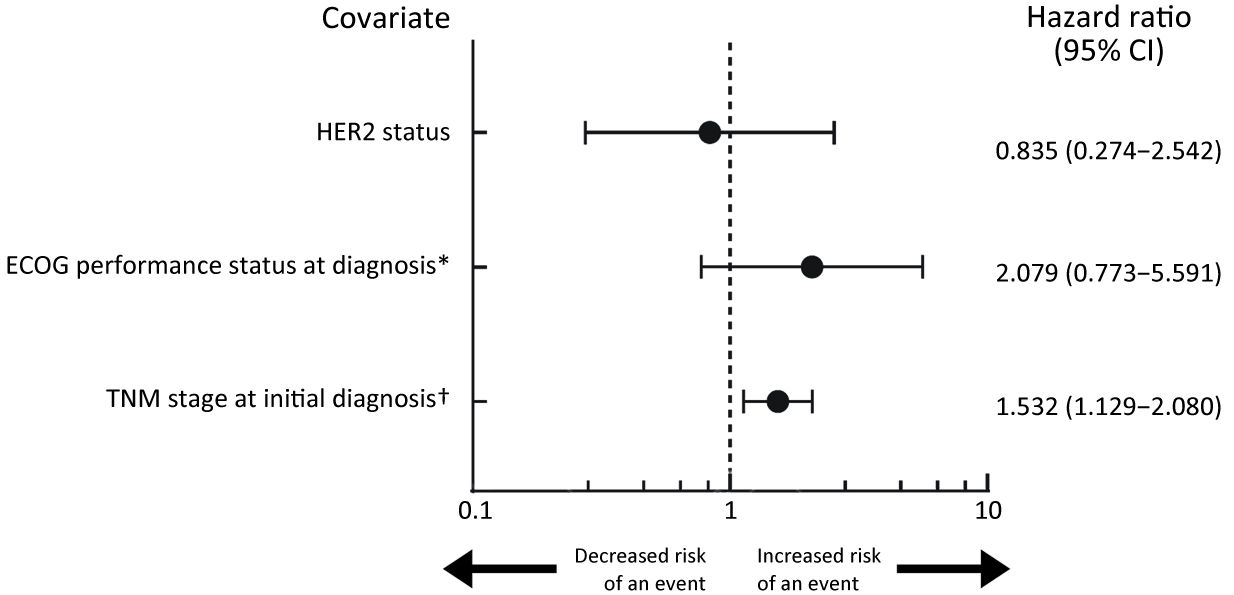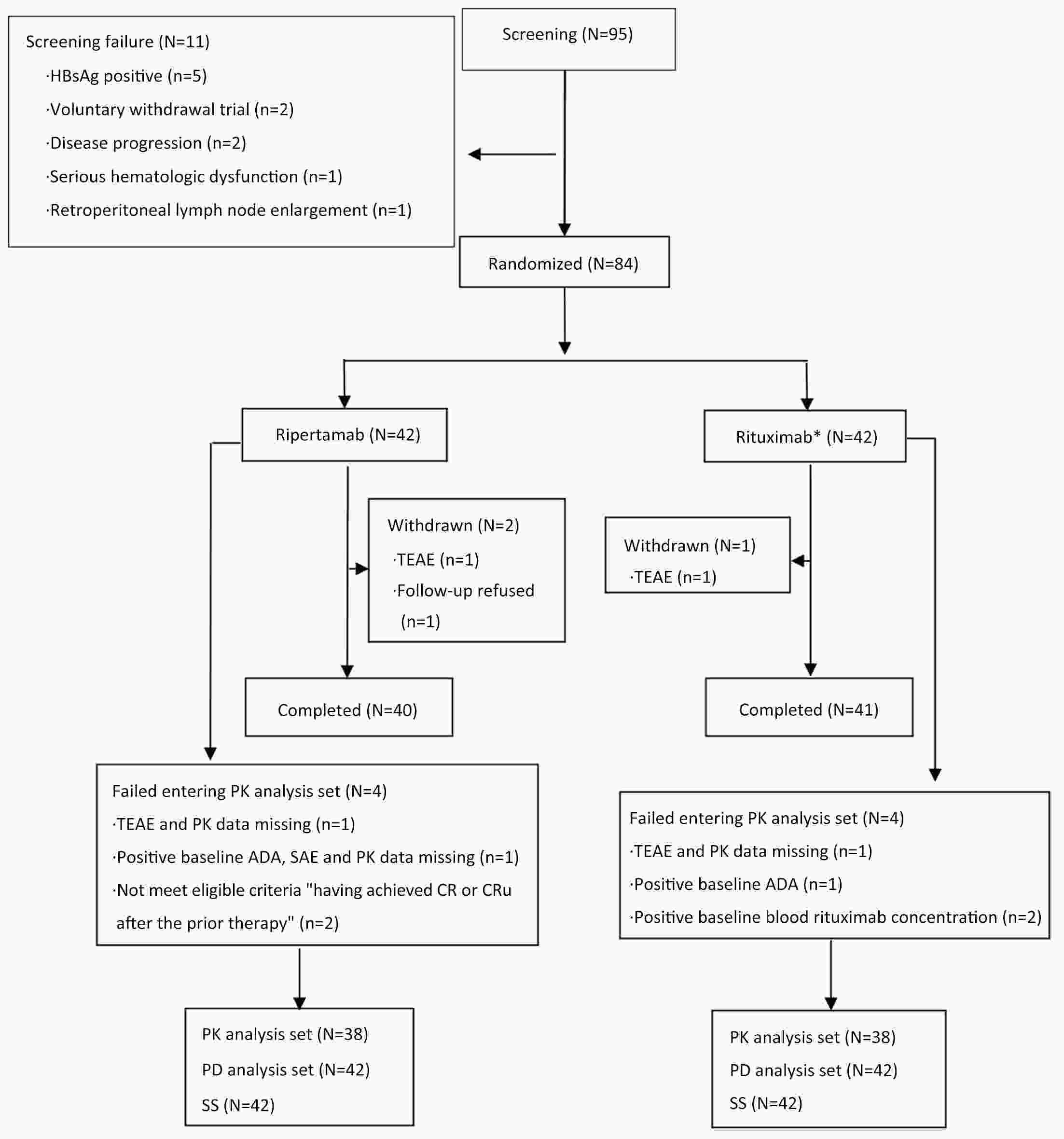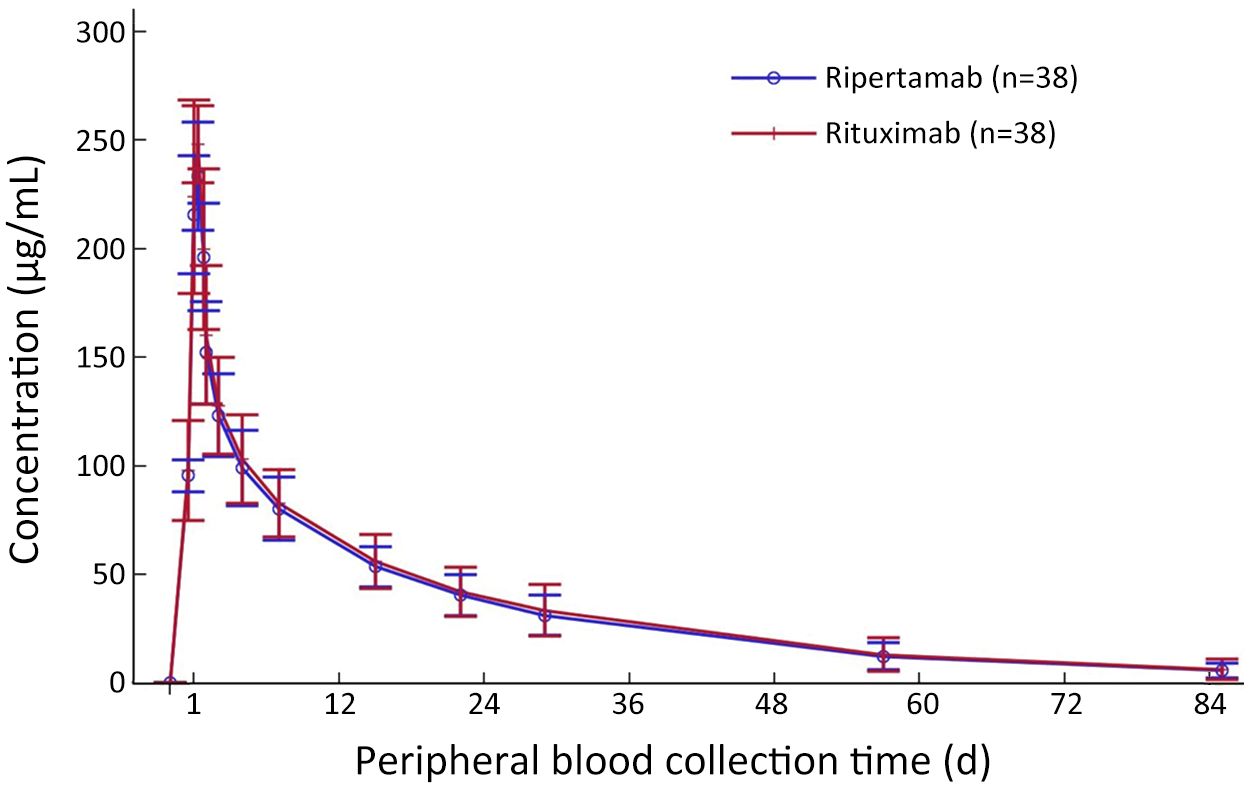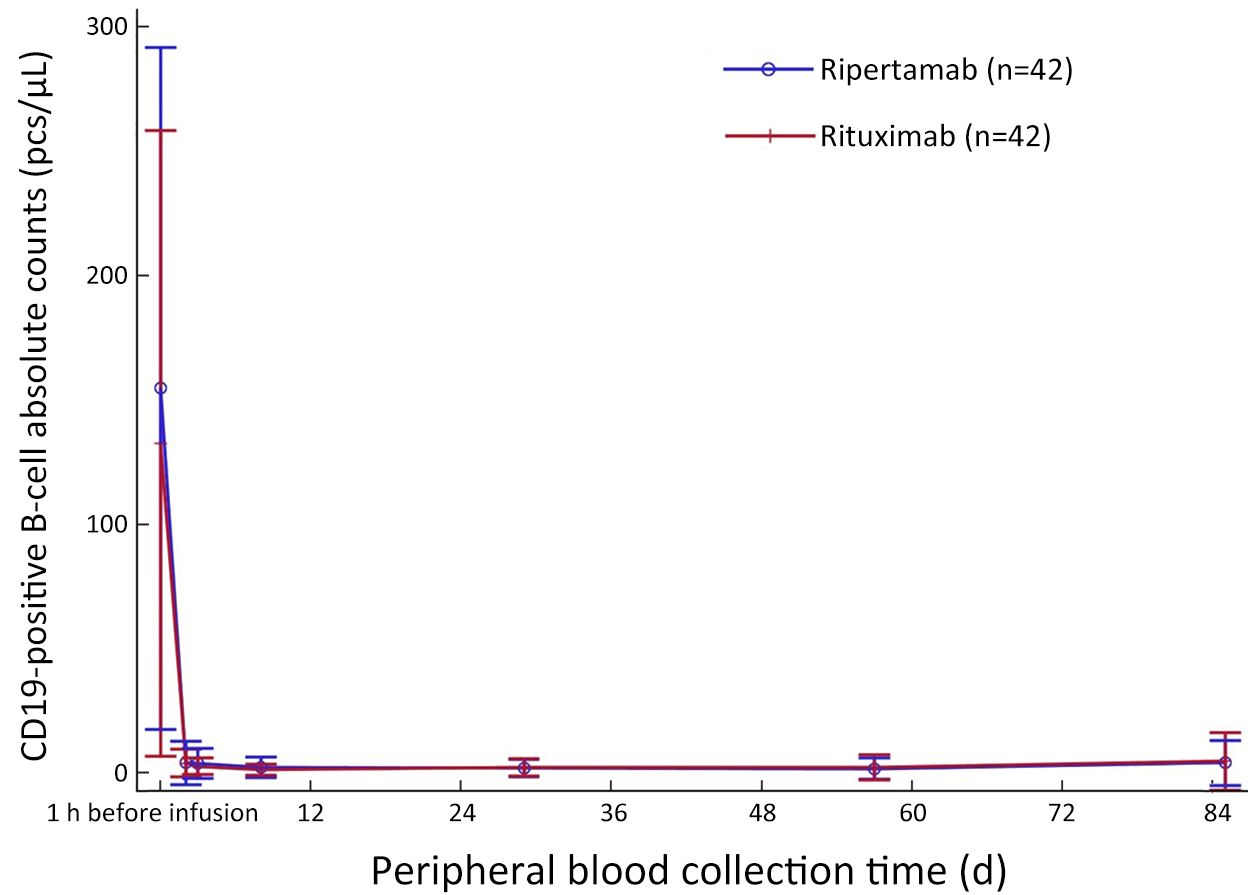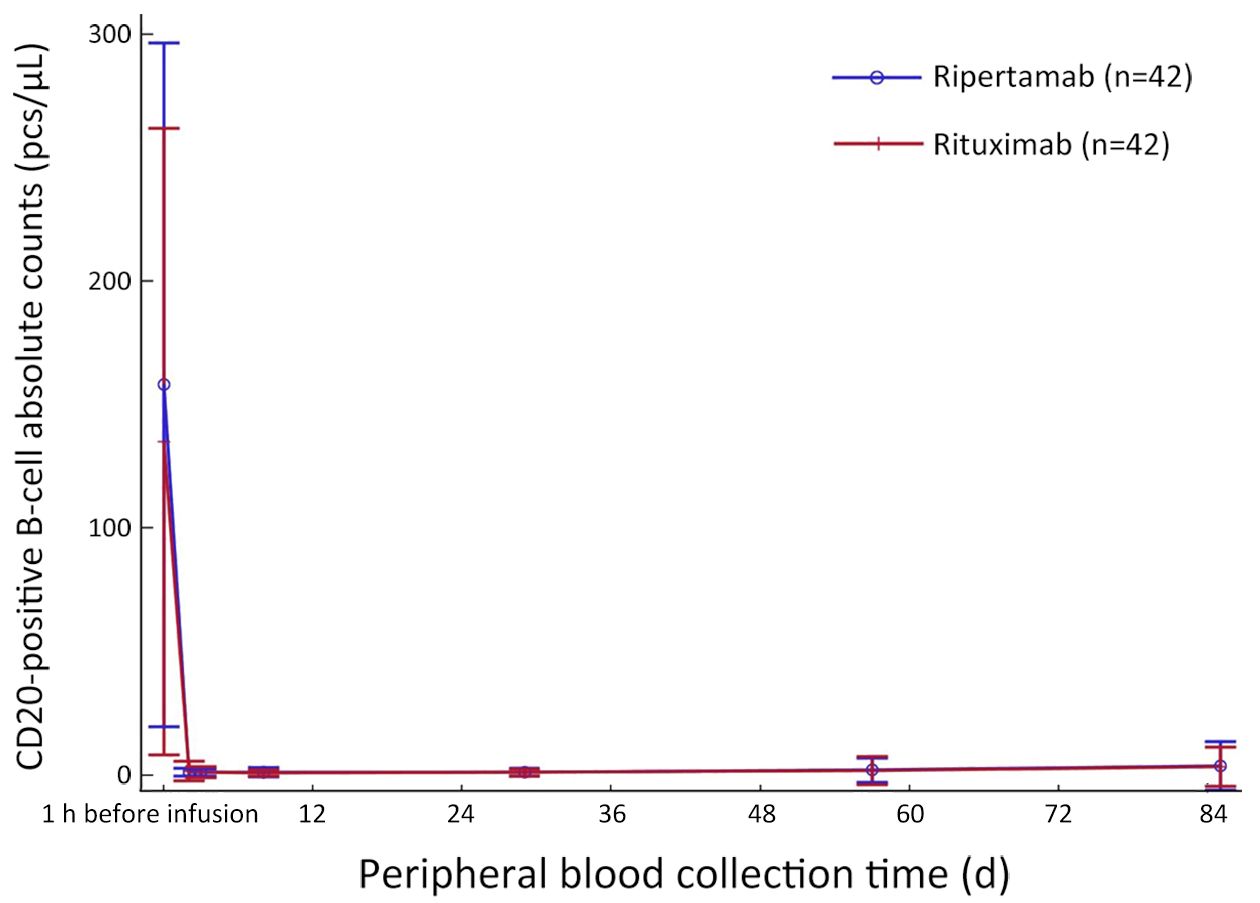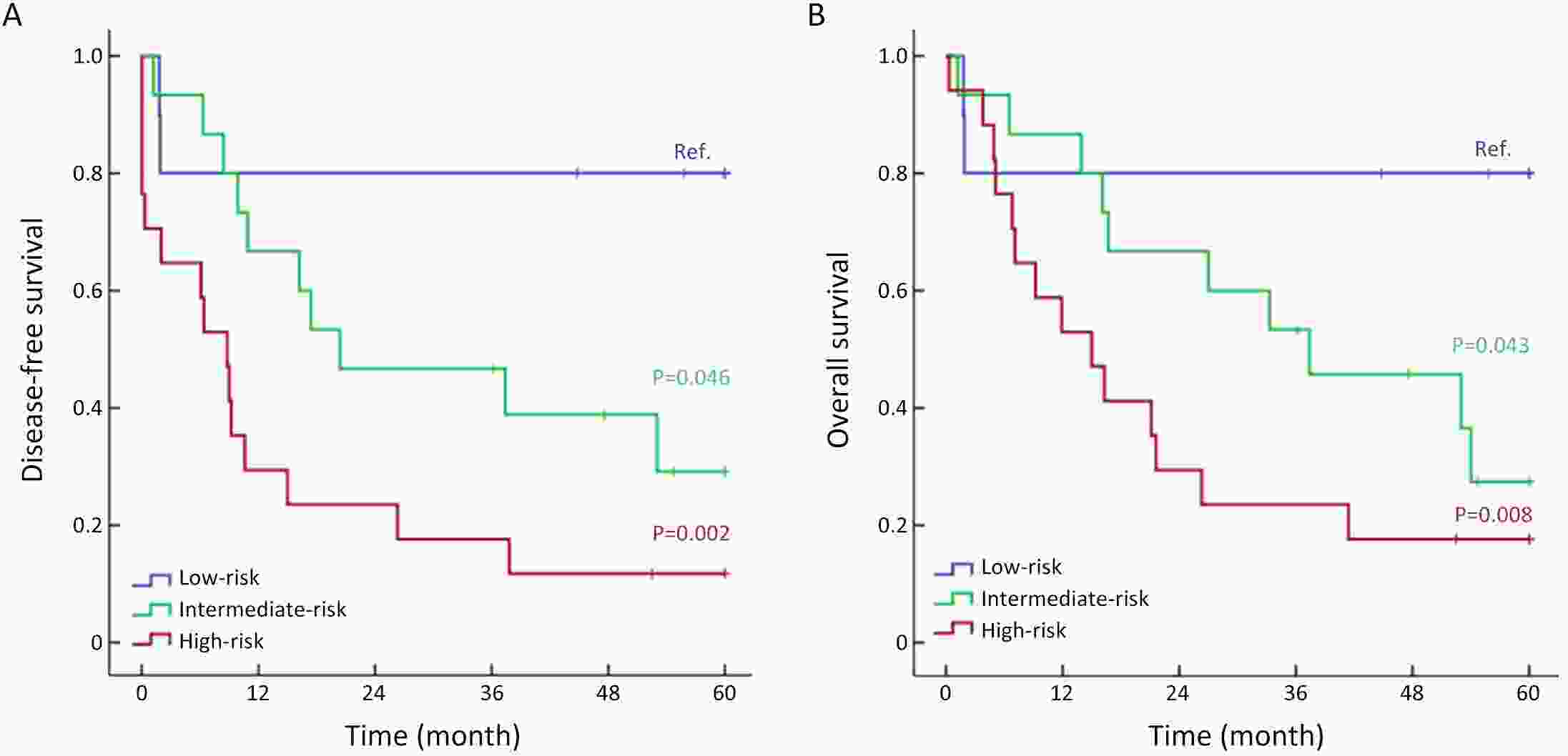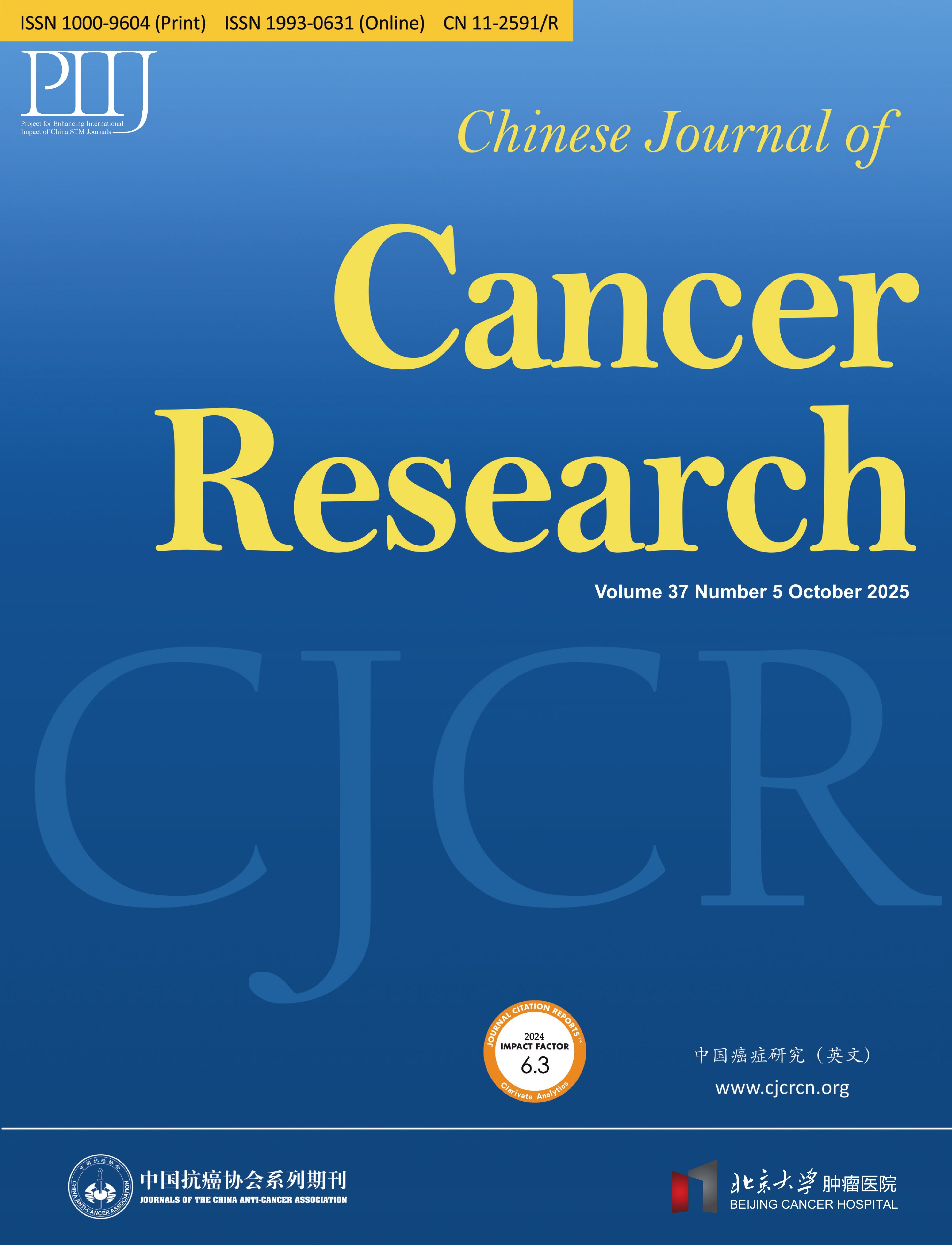2022 Vol.34(6)
Display Mode: |
2022, 34(6): 543-553.
doi: 10.21147/j.issn.1000-9604.2022.06.01
Abstract:
Tumor microenvironment (TME) is highly heterogeneous and composed of complex cellular components, including multiple kinds of immune cells. Among all immune cells in TME, tumor-infiltrating myeloid cells (TIMs) account for a large proportion and play roles as key regulators in a variety of functions, ranging from immune-mediated tumor killing to tumor immune evasion. Understanding the heterogeneity of TIMs will provide valuable insights for new therapeutic targeting of myeloid cells. Single-cell genomic technologies deciphering cell composition and gene expression at single-cell resolution have largely improved our understanding of the cellular heterogeneity of TIMs and highlighted several novel cell subtypes contributing to the variation of patient survival and treatment response. However, these cell subtypes were defined based on limited data without a concordant nomenclature, which makes it difficult to understand whether they exist in different studies. Thus, in this review, we comprehensively summarized the common agreements and current different opinions on the heterogeneity of TIMs gained from single-cell studies; evaluated the feasibility of current myeloid cell targets at single-cell level and proposed a uniform nomenclature for TIM subsets.
Tumor microenvironment (TME) is highly heterogeneous and composed of complex cellular components, including multiple kinds of immune cells. Among all immune cells in TME, tumor-infiltrating myeloid cells (TIMs) account for a large proportion and play roles as key regulators in a variety of functions, ranging from immune-mediated tumor killing to tumor immune evasion. Understanding the heterogeneity of TIMs will provide valuable insights for new therapeutic targeting of myeloid cells. Single-cell genomic technologies deciphering cell composition and gene expression at single-cell resolution have largely improved our understanding of the cellular heterogeneity of TIMs and highlighted several novel cell subtypes contributing to the variation of patient survival and treatment response. However, these cell subtypes were defined based on limited data without a concordant nomenclature, which makes it difficult to understand whether they exist in different studies. Thus, in this review, we comprehensively summarized the common agreements and current different opinions on the heterogeneity of TIMs gained from single-cell studies; evaluated the feasibility of current myeloid cell targets at single-cell level and proposed a uniform nomenclature for TIM subsets.
2022, 34(6): 554-566.
doi: 10.21147/j.issn.1000-9604.2022.06.02
Abstract:
In this review, we offer a concise overview of liver cancer epidemiology in China and worldwide from the official databases of GLOBOCAN 2020 and the National Cancer Registry in China. We also summarized the evidence for the main risk factors associated with liver cancer risk and discuss strategies implemented in China to control the liver cancer burden. Overall, liver cancer was the sixth most commonly diagnosed cancer and the third leading cause of cancer-related death worldwide in 2020. Although China contributed to nearly half of cases across the world alone, the incidence and mortality rates of liver cancer presented a declining trend owing to the persistent efforts from the governments at all levels. The current liver cancer burden in China still faces an arduous challenge due to the relatively large population base as well as the substantially low survival rate (12.1%). To better control the liver cancer burden with the lowest cost, specific measures should be conducted by reducing exposure to established risk factors such as hepatitis B infection and aflatoxin. The promotion of surveillance is also an important method to prolong the survival of liver cancer. This review will provide basic information for future direction on the control of liver cancer burden.
In this review, we offer a concise overview of liver cancer epidemiology in China and worldwide from the official databases of GLOBOCAN 2020 and the National Cancer Registry in China. We also summarized the evidence for the main risk factors associated with liver cancer risk and discuss strategies implemented in China to control the liver cancer burden. Overall, liver cancer was the sixth most commonly diagnosed cancer and the third leading cause of cancer-related death worldwide in 2020. Although China contributed to nearly half of cases across the world alone, the incidence and mortality rates of liver cancer presented a declining trend owing to the persistent efforts from the governments at all levels. The current liver cancer burden in China still faces an arduous challenge due to the relatively large population base as well as the substantially low survival rate (12.1%). To better control the liver cancer burden with the lowest cost, specific measures should be conducted by reducing exposure to established risk factors such as hepatitis B infection and aflatoxin. The promotion of surveillance is also an important method to prolong the survival of liver cancer. This review will provide basic information for future direction on the control of liver cancer burden.
2022, 34(6): 567-574.
doi: 10.21147/j.issn.1000-9604.2022.06.03
Abstract:
To improve the quality of surgical procedures for gastric cancer, it is essential to consider many components comprehensively, including gastric motility, small intestinal absorption, hormones that affect gastric motility and appetite, presence or absence of vagus nerve preservation, esophageal regurgitation on endoscopic findings, in addition to whether or not there is a physiological route for food passage through the duodenum. Furthermore, proper functional evaluation cannot be performed without considering the form and amount of energy in the nutritional supplement to be loaded, and the posture at the time of investigation. The results of functional evaluation vary according to the method selected from many available options, but we believe that use of the most physiologically accurate, appropriate and selectable option will enable us to arrive at the best resection/reconstruction technique. We have reported that it is important to consider the preservation of three elements when performing gastrectomy: 1) reduction of the extent of gastrectomy, 2) preservation of the pylorus, and 3) preservation of the vagus nerve; among which preservation of the remnant stomach is the most important. Furthermore, the selection of a reconstruction method that maintains secretion of hormones beneficial to gastric motility preserves the energy balance inherent in the human body, and also provides better quality of life.
To improve the quality of surgical procedures for gastric cancer, it is essential to consider many components comprehensively, including gastric motility, small intestinal absorption, hormones that affect gastric motility and appetite, presence or absence of vagus nerve preservation, esophageal regurgitation on endoscopic findings, in addition to whether or not there is a physiological route for food passage through the duodenum. Furthermore, proper functional evaluation cannot be performed without considering the form and amount of energy in the nutritional supplement to be loaded, and the posture at the time of investigation. The results of functional evaluation vary according to the method selected from many available options, but we believe that use of the most physiologically accurate, appropriate and selectable option will enable us to arrive at the best resection/reconstruction technique. We have reported that it is important to consider the preservation of three elements when performing gastrectomy: 1) reduction of the extent of gastrectomy, 2) preservation of the pylorus, and 3) preservation of the vagus nerve; among which preservation of the remnant stomach is the most important. Furthermore, the selection of a reconstruction method that maintains secretion of hormones beneficial to gastric motility preserves the energy balance inherent in the human body, and also provides better quality of life.
2022, 34(6): 575-578.
doi: 10.21147/j.issn.1000-9604.2022.06.04
Abstract:
Gastric adenocarcinoma (GC) is one of the most heterogeneous cancers, posing challenges to wide applications of the discoveries when compared to other cancers. Nevertheless, the benefits of research in the fight against GC are extraordinary, and even taking in mind the immense complexity of this disease, optimism is a great message to take home. Recent advances in GC research will pave the way for GC effective control, helping to save lives, together with permitting sustainable real-life support for those needing complex and high-expense interventions.
Gastric adenocarcinoma (GC) is one of the most heterogeneous cancers, posing challenges to wide applications of the discoveries when compared to other cancers. Nevertheless, the benefits of research in the fight against GC are extraordinary, and even taking in mind the immense complexity of this disease, optimism is a great message to take home. Recent advances in GC research will pave the way for GC effective control, helping to save lives, together with permitting sustainable real-life support for those needing complex and high-expense interventions.
2022, 34(6): 579-586.
doi: 10.21147/j.issn.1000-9604.2022.06.05
Abstract:
Laparoscopic gastrectomy has evolved differently in Eastern and Western countries. Feasibility, safety and oncological outcomes of laparoscopic gastrectomy were addressed step-by-step by several randomized controlled trials from the East. Few phase III studies were published from the West that largely did not show a difference between the laparoscopic and open approach. Despite this, laparoscopic gastrectomy is seen as the standard for the surgical treatment of early and advanced gastric cancer in many European countries. Here, we review and comment on some important studies on laparoscopic gastrectomy for gastric cancer from Eastern and Western countries and also comment on current and future challenges.
Laparoscopic gastrectomy has evolved differently in Eastern and Western countries. Feasibility, safety and oncological outcomes of laparoscopic gastrectomy were addressed step-by-step by several randomized controlled trials from the East. Few phase III studies were published from the West that largely did not show a difference between the laparoscopic and open approach. Despite this, laparoscopic gastrectomy is seen as the standard for the surgical treatment of early and advanced gastric cancer in many European countries. Here, we review and comment on some important studies on laparoscopic gastrectomy for gastric cancer from Eastern and Western countries and also comment on current and future challenges.
2022, 34(6): 587-591.
doi: 10.21147/j.issn.1000-9604.2022.06.06
Abstract:
Surgery is still the primary curative treatment for gastric cancer, which includes resection of the tumor with adequate margins and extended lymphadenectomy. In order to improve the operative results and the quality of life of patients, several endeavors have been made toward precision medicine through image-guided surgery, allowing access to real-time intraoperative anatomy and accurate tumor staging. The goal of the surgeon is to achieve a more precise, individualized, and less invasive surgery without compromising oncological efficiency and safety. In this perspective, we have demonstrated the role of indocyanine green (ICG) and near-infrared (NIR) fluorescence imaging method in gastric cancer surgery. This technique may be used to improve localization of the tumor, detection of sentinel lymph nodes (SLN), real-time lymphatic mapping, and blood flow assessment (anastomosis perfusion).
Surgery is still the primary curative treatment for gastric cancer, which includes resection of the tumor with adequate margins and extended lymphadenectomy. In order to improve the operative results and the quality of life of patients, several endeavors have been made toward precision medicine through image-guided surgery, allowing access to real-time intraoperative anatomy and accurate tumor staging. The goal of the surgeon is to achieve a more precise, individualized, and less invasive surgery without compromising oncological efficiency and safety. In this perspective, we have demonstrated the role of indocyanine green (ICG) and near-infrared (NIR) fluorescence imaging method in gastric cancer surgery. This technique may be used to improve localization of the tumor, detection of sentinel lymph nodes (SLN), real-time lymphatic mapping, and blood flow assessment (anastomosis perfusion).
2022, 34(6): 592-600.
doi: 10.21147/j.issn.1000-9604.2022.06.07
Abstract:
ObjectiveThis post-approval safety study assessed the efficacy and safety of exemestane after 2−3 years of tamoxifen treatment among postmenopausal women with estrogen receptor-positive (ER+) early breast cancer in China. MethodsEnrolled patients had received 2−3 years of tamoxifen and were then switched to exemestane for completion of 5 consecutive years of adjuvant endocrine therapy. The primary endpoint was the time from enrollment to the first occurrence of locoregional/distant recurrence of the primary breast cancer, appearance of a second primary or contralateral breast cancer, or death due to any cause. Other endpoints included the proportion of patients experiencing each event, incidence rate per annum, relationships between human epidermal growth factor receptor 2 status and time to event, and relationship between disease history variables and time to event. ResultsOverall, 558 patients were included in the full analysis set: 397 (71.1%) completed the study, 20 experienced an event, and 141 discontinued [47 owing to an adverse event (AE); 37 no longer willing to participate]. Median duration of treatment was 29.5 (range, 0.1−57.7) months. Median time to event was not reached. Event-free survival probability at 36 months was 91.4% (95% CI, 87.7%−95.1%). The event incidence over the total exposure time of exemestane therapy was 3.5 events/100 person-years (20/565). Multivariate analysis showed an association between tumor, lymph node, and metastasis stage at initial diagnosis and time to event [hazard ratio: 1.532 (95% CI, 1.129−2.080); P=0.006]. Most AEs were grade 1 or 2 in severity, with arthralgia (7.7%) being the most common treatment-related AE. ConclusionsThis study supports the efficacy and safety of exemestane in postmenopausal Chinese women with ER+ breast cancer previously treated with adjuvant tamoxifen for 2−3 years. No new safety signals were identified in the Chinese population.
2022, 34(6): 601-611.
doi: 10.21147/j.issn.1000-9604.2022.06.08
Abstract:
ObjectiveThis multi-center, open-label, randomized, parallel-controlled phase II study aimed to compare the pharmacokinetics (PK), pharmacodynamics (PD) and safety profile of ripertamab (SCT400), a recombinant anti-CD20 monoclonal antibody, to rituximab (MabThera®) in patients with CD20-positive B-cell non-Hodgkin lymphoma (NHL). MethodsPatients with CD20-positive B-cell NHL who achieved complete remission or unconfirmed complete remission after standard treatment were randomly assigned at a 1:1 ratio to receive a single dose of ripertamab (375 mg/m2) or rituximab (MabThera®, 375 mg/m2). PK was evaluated using area under the concentration-time curve (AUC) from time 0 to d 85 (AUC0−85 d), AUC from time 0 to week 1 (AUC0−1 w), AUC from time 0 to week 2 (AUC0−2 w), AUC from time 0 to week 3 (AUC0−3 w), AUC from time 0 to week 8 (AUC0−8 w), maximum serum concentration (Cmax), terminal half-life (T1/2), time to maximum serum concentration (Tmax) and clearance (CL). Bioequivalence was confirmed if the 90% confidence interval (90% CI) of the geometric mean ratio of ripertamab/rituximab was within the pre-defined bioequivalence range of 80.0%−125.0%. PD, immunogenicity, and safety were also evaluated. ResultsFrom December 30, 2014 to November 24, 2015, a total of 84 patients were randomized (ripertamab, n=42; rituximab, n=42) and the PK analysis was performed on 76 patients (ripertamab, n=38; rituximab, n=38). The geometric mean ratios of ripertamab/rituximab for AUC0−85 d, AUC0−inf, and Cmax were 96.1% (90% CI: 87.6%−105.5%), 95.9% (90% CI: 86.5%−106.4%) and 97.4% (90% CI: 91.6%−103.6%), respectively. All PK parameters met the pre-defined bioequivalence range of 80.0%−125.0%. For PD and safety evaluation, there was no statistical difference in peripheral CD19-positive B-cell counts and CD20-positive B-cell counts at each visit, and no difference in the incidence of anti-drug antibodies was observed between the two groups. The incidences of treatment-emergent adverse events and treatment-related adverse events were also comparable between the two groups. ConclusionsIn this study, the PK, PD, immunogenicity, and safety profile of ripertamab (SCT400) were similar to rituximab (MabThera®) in Chinese patients with CD20-positive B-cell NHL.
2022, 34(6): 612-622.
doi: 10.21147/j.issn.1000-9604.2022.06.09
Abstract:
ObjectiveRemnant gastric cancer (RGC) is usually associated with a worse prognosis. As they are less common and very heterogeneous tumors, new prognostic and reliable determinants are required to predict patients’ clinical course for RGC. This study aimed to investigate the tumor-infiltrating lymphocytes (TILs) and programmed cell death ligand 1 (PD-L1) status as prognostic biomarkers in a cohort of patients with RGC to develop an immune-related score. MethodsPatients with gastric cancer (GC) who underwent curative intent gastrectomy were retrospectively investigated. RGC resections with histological diagnosis of gastric adenocarcinoma were enrolled in the study. The risk score based on immune parameters was developed using binary logistic regression analysis. RGCs were divided into high-risk (HR), intermediate-risk (IR), and low-risk (LR) groups based on their immune score. The markers (CD3+, CD4+/CD8+ T cells and PD-L1) were selected for their potential prognostic, therapeutic value, and evaluated by immunohistochemistry (IHC). ResultsA total of 42 patients with RGC were enrolled in the study. The score based on immune parameters exhibited an accuracy of 79% [the area under the receiver operating characteristic curve (AUC)=0.79, 95% confidence interval (95% CI), 0.63−0.94, P=0.002], and the population was divided into 3 prognostic groups: 10 (23.8%) patients were classified as LR, 15 (35.7%) as IR, and 17 (40.5%) as HR groups. There were no differences in clinicopathological and surgical characteristics between the three groups. In survival analysis, HR and IR groups had worse disease-free survival and overall survival rates compared to the LR group. In the multivariate analysis, lymph node metastasis and the immune score risk groups were independent factors related to worse survival. ConclusionsA scoring system with immune-related markers was able to distinguish prognostic groups of RGC associated with survival. Accordingly, tumor-infiltrating immune lymphocytes and PD-L1 status may serve as a potential prognostic biomarker for patients with RGC.
2022, 34(6): 623-632.
doi: 10.21147/j.issn.1000-9604.2022.06.10
Abstract:
Gastric cancer is one of the most common malignancies of the digestive system, and the number of deaths continues to increase. The standardized management of the diagnosis and treatment of gastric cancer is challenging due to the great differences in the diagnosis and treatment of gastric cancer in different regions. The Gastric Cancer Expert Committee of the National Cancer Quality Control Center (NCQCC) identified a lack of authoritative quality control standards as an opportunity to utilize its multidisciplinary membership to improve the standardized diagnosis and treatment of gastric cancer. The Gastric Cancer Expert Committee of the NCQCC aims to promote quality control and national standardization, uniformity, and normalization of gastric cancer diagnosis and treatment, which ultimately improved the survival rate and quality of life of gastric cancer patients. A panel of experts with gastrointestinal cancer surgery, gastrointestinal cancer medicine, medical imaging, pathology and radiotherapy were drawn together and determined the quality control standards for the standardized diagnosis and treatment of gastric cancer. The authors then utilized a modified Delphi approach to generate consensus recommendations.
Gastric cancer is one of the most common malignancies of the digestive system, and the number of deaths continues to increase. The standardized management of the diagnosis and treatment of gastric cancer is challenging due to the great differences in the diagnosis and treatment of gastric cancer in different regions. The Gastric Cancer Expert Committee of the National Cancer Quality Control Center (NCQCC) identified a lack of authoritative quality control standards as an opportunity to utilize its multidisciplinary membership to improve the standardized diagnosis and treatment of gastric cancer. The Gastric Cancer Expert Committee of the NCQCC aims to promote quality control and national standardization, uniformity, and normalization of gastric cancer diagnosis and treatment, which ultimately improved the survival rate and quality of life of gastric cancer patients. A panel of experts with gastrointestinal cancer surgery, gastrointestinal cancer medicine, medical imaging, pathology and radiotherapy were drawn together and determined the quality control standards for the standardized diagnosis and treatment of gastric cancer. The authors then utilized a modified Delphi approach to generate consensus recommendations.
2022, 34(6): 633-634.
doi: 10.21147/j.issn.1000-9604.2022.06.11
Abstract:
2022, 34(6): 635-636.
doi: 10.21147/j.issn.1000-9604.2022.06.12
Abstract:
2022, 34(6): 637-643.
doi: 10.21147/j.issn.1000-9604.2022.06.13
Abstract:
2022, 34(6): 644-644.
doi: 10.21147/j.issn.1000-9604.2022.06.14
Abstract:

 Abstract
Abstract FullText HTML
FullText HTML PDF 2857KB
PDF 2857KB